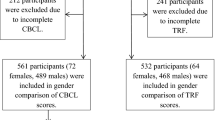Summary
This study examined the association of problem behavior with neurotransmitter deficiency in adolescents, which would provide new insights into behavioral problems. A total of 1259 students of the seventh grade from 4 middle schools in Wuhan city located in the central China were recruited. With the approval of school and parents, they were invited to complete the Youth Self-Report (YSR) questionnaire and Symptom Scale of Neurotransmitter Deficiency (SSND) questionnaire. Pearson’s bivariate correlation analysis showed that the correlation coefficients between each subscale of YSR and SSND ranged from 0.24 to 0.61 with all P<0.01. Canonical correlation analysis indicated that anxiety/depression was interrelated with insufficiency of GABA and 5-HT; aggressive behavior was associated with inadequate GABA; famine of DA influenced the attention problems. It was concluded that neurotransmitter deficiency may cause a series of behavioral and mental problems.
Similar content being viewed by others
References
Slobodskaya HR. Competence, emotional and behavioural problems in Russian adolescents. Eur Child Adolesc Psychiatry, 1999,8(3):173–180
Brandenburg NA, Friedman RM, Silver SE. The epidemiology of childhood psychiatric disorders: prevalence findings from recent studies. J Am Acad Child Adolesc Psychiatry, 1990,29(1):76–83
Taras, HL. School-based mental health services. Pediatrics, 2004,113(6):1839–1845
Barkmann C, Schulte-Markwort M. Emotional and behavioral problems of children and adolescents in Germany3—an epidemiological screening. Soc Psychiatry Psychiatr Epidemiol, 2005,40(5):357–366
Liu XC, Kurita H, Guo CQ, et al. Behavioral and emotional problems in Chinese children: teacher reports for ages 6 to 11. J Child Psychol Psychiatry, 2000,41(2): 253–260
Zhang C. Comparative study on the psychological problem among Chinese and American school children. Mod Prev Med (Chinese), 2006,33(10):1911–1913
Wu HR. The prevention and treatment of adolescent behavioral problems. Chin J Sch Health (Chinese), 2004,25(6):773–775
Hicks BM, South SC, DiRago AC, et al. Environmental adversity and increasing genetic risk for externalizing disorders. Arch Gen Psychiatry, 2009,66(6):640–648
Liu XC, Kurita H, Guo CQ, et al. Prevalence and risk factors of behavioral and emotional problems among Chinese children aged 6 through 11 years. J Am Acad Child Adolesc Psychiatry, 1999,38(6):708–715
Ball D, Hill L, Freeman B,et al. The serotonin transporter gene and peer-rated neuroticism. Neuroreport, 1997,8(5): 1301–1304
Liu JJ, Li SM, Chen RB. Study on the blood acetylcholine levels in children with mental retardation. J Shantou Univ Med Coll (Chinese), 2009,22(1):32–34
Wong MM, Brower KJ, Zucker RA. Childhood sleep problems, early onset of substance use and behavioral problems in adolescence. Sleep Med, 2009,10(7): 787–796
Kantomaa MT, Tammelin TH, Ebeling HE, et al. Emotional and behavioral problems in relation to physical activity in youth. Med Sci Sports Exerc, 2008,40(10):1749–1756
Bartlett R, Holditch-Davis D, Belyea M, et al. Risk and protection in the development of problem behaviors in adolescents. Res Nurs Health, 2006,29(6):607–621
Qi MX, Chen S, Huang XR, et al. Dopamine content in serum of myopia. Chin Ophthalmol Res (Chinese), 2003,21(3):316–317
Petty F. GABA and mood disorders: a brief review and hypothesis. J Affect Disord, 1995,34(4):275–281
Zheng SH, Tang CH, Liu FY. Relationship between child behavior problem and the concentration of 5-HT in serum. Clini Psychosom Dis (Chinese), 2001,7(4): 200–202
Braverman ER. The Edge Effect: Achieve total health and longevity with the balanced brain advantage. Sterling Publishing Co. New York. 2004.
Achenbach TM. Manual for the YSR and 1991 profile. Burlington, VT: University of Vermont, Department of Psychiatry. 1991.
Leung PW, Kwong SL, Tang CP, et al. Test-retest reliability and criterion validity of the Chinese version of CBCL, TRF, and YSR. J Child Psychol Psychiatry, 2006,47(9): 970–973
Steinhausen HC, Metzke CW. Youth Self-Report of behavioral and emotional problems in a Swiss epidemiological study. J Youth Adolesc, 1998,27(4):429–441
Tang GZ, Guo LT, Huang XZ. The norms of Youth Self-Report (behaviour problems) in Chengdu city. Chin J Ment Health (Chinese), 2005,19(3):183–186
Maslaeh C, Jackson, SE. Maslach Burnout Inventory manual, 2nd edition. Palo Alto, CA: Consulting Psychologist Press. 1986.
Honig A, Bartlett JR, Bouras N, et al. Amino acid levels in depression: a preliminary investigation. J Psychiatr Res, 1988,22(3):159–164
Kraemer GW, Moore CF, Newman TK, et al. Moderate level fetal alcohol exposure and serotonin transporter gene promoter polymorphism affect neonatal temperament and LHPA axis regulation in monkeys. Biol Psychiatry, 2008,63(3):317–324
Miczek KA, Fish EW, De Bold JF, et al. Social and neural determinants of aggressive behavior: pharmacotherapeutic targets at serotonin, dopamine and gamma-aminobutyric acid systems. Psychopharmacology (Berl), 2002,163(3): 434–458
Bjork JM, Moeller FG, Kramer GL, et al. Plasma GABA levels correlate with aggressiveness in relatives of patients with unipolar depressive disorder. Psychiatry Res, 2001, 101(2):131–136
Dellwo A. Dopamine in fibromyalgia & chronic fatigue syndrome, low dopamine: how it makes you feel & how to fix it [Online].
Author information
Authors and Affiliations
Corresponding authors
Rights and permissions
About this article
Cite this article
Song, X., Wang, H., Zheng, L. et al. The relationship between problem behavior and neurotransmitter deficiency in adolescents. J. Huazhong Univ. Sci. Technol. [Med. Sci.] 30, 714–719 (2010). https://doi.org/10.1007/s11596-010-0646-7
Received:
Published:
Issue Date:
DOI: https://doi.org/10.1007/s11596-010-0646-7




